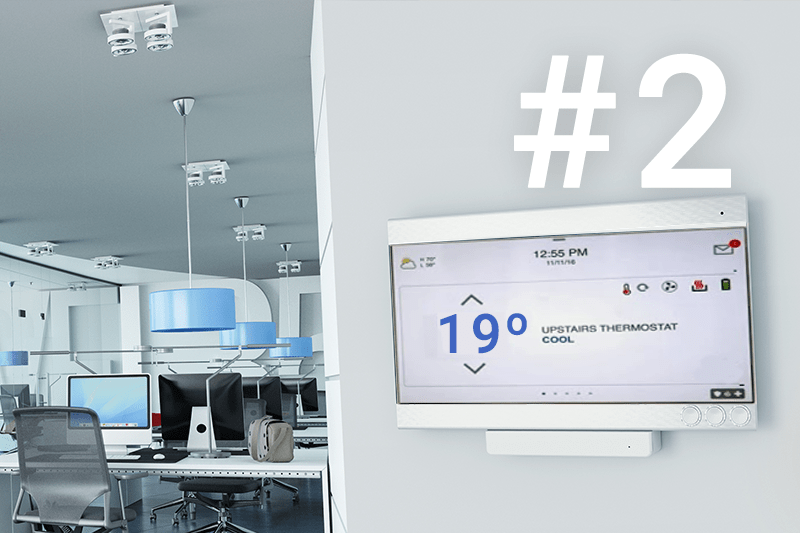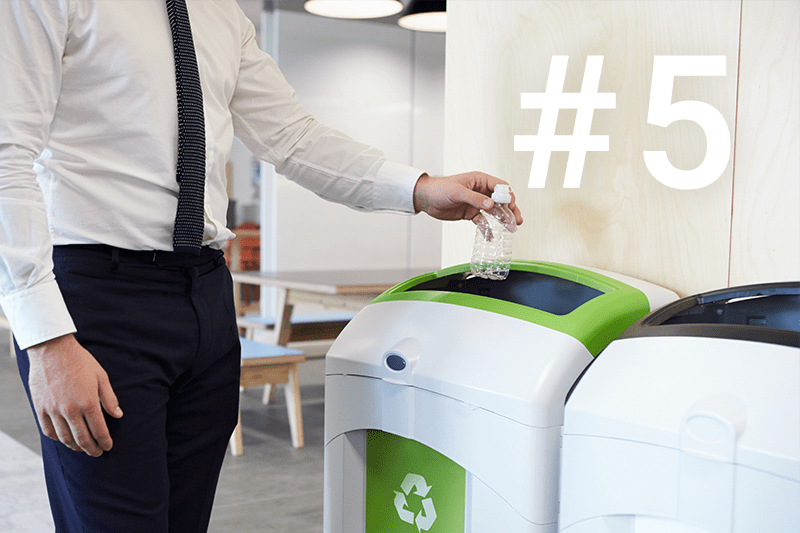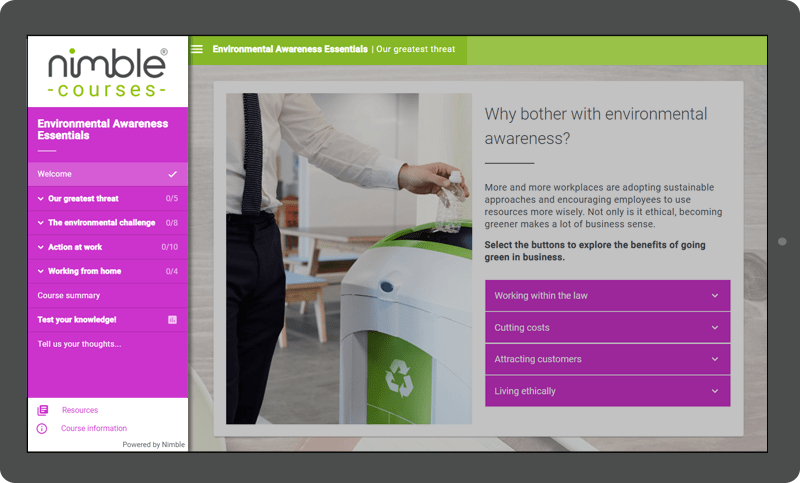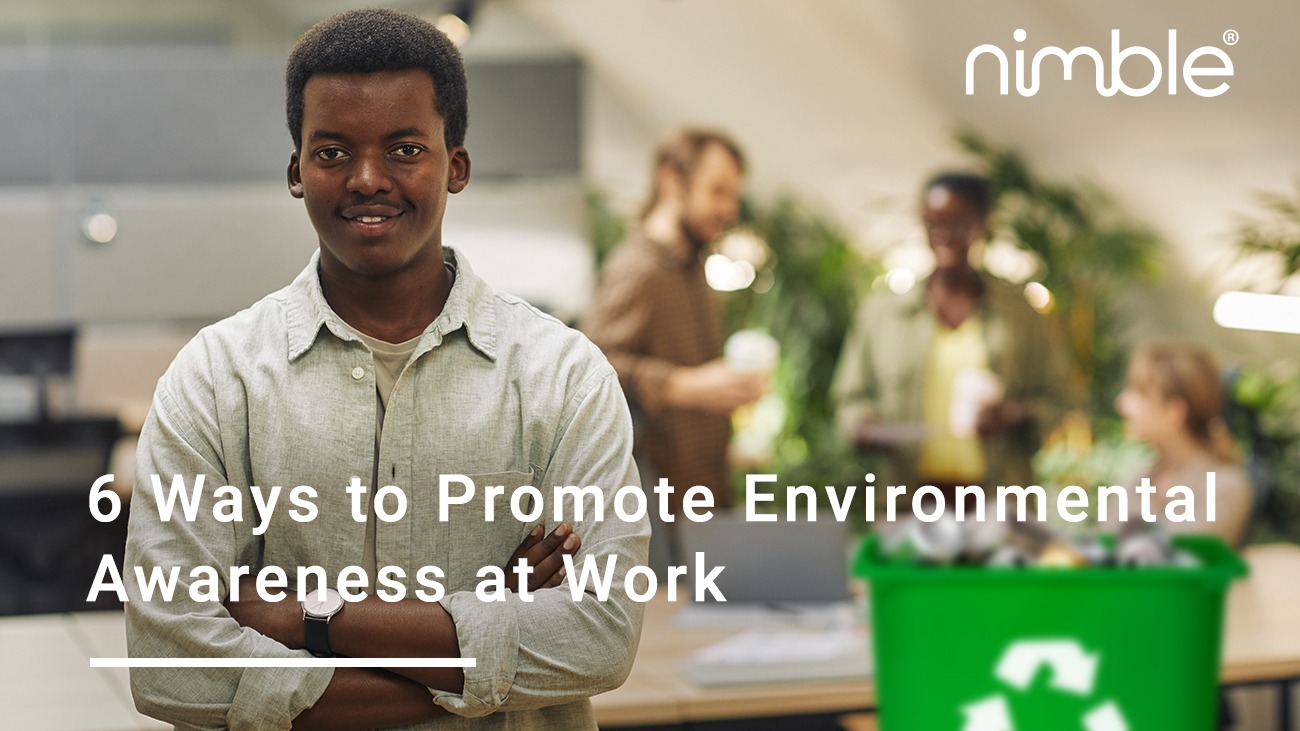Estimated reading time: 8 minutes
We all know that it’s our collective responsibility to care for the environment, but the truth is that it can be an overwhelming prospect. It’s easy to feel like our individual actions won’t add up to much, but each of us can make simple choices that keep sustainability in mind and have a real impact on our planet. At Nimble, we strive to support our customers in their efforts to make positive changes for the good of the environment, in fact, we’ve recently released a free course on the subject for eligible Nimble LMS subscribers; take a look at the demonstration of our Environmental Awareness Essentials course now.
We spend a lot of our time at work, so it makes sense to prioritise environmental issues in the workplace. But if an organisation isn’t exactly the greenest, even the most committed eco-warrior is unlikely to feel comfortable shaking it up in the workplace without the support of management. How can we make it easy for employees to make sustainable choices every day? Read on for six simple ways to get started.

1: Reach for the power switch
Have you ever walked past an office block at night, only to see it lit up like a Christmas tree? It’s less prevalent nowadays, but it’s still important to make sure that all lights are switched off when the office is locked up for the day, and appliances are properly powered down. Why not create a simple checklist to put up on the wall as a reminder before staff leave the site?
- Heating or air conditioning off
- Monitors off
- Workstations powered down
- Printers turned off at the plug
- Windows and blinds closed
- Lights off

2: Avoid thermostat wars
The office temperature battle: something familiar to all of us, no doubt! Each person’s comfortable resting temperature can vary quite widely (with women tending to prefer a warmer ambient temperature than men – in fact, one study showed that women’s performance on a task was higher in a warmer environment, with the opposite proving true for men). So how can we find a happy medium that suits as many employees as possible?
In terms of keeping sustainability in mind, it obviously uses less energy to maintain a cooler temperature in winter and a warmer one in summer – but, generally speaking, a temperature of around 19-22°C is just right for typical office tasks. It’s also reasonable to expect employees to bring an extra layer along just in case they get chilly! Don’t forget to maximise the efficiency of any heating system, too; make sure radiators and vents are kept clear, and any draughts are sorted out. In the summer, let the thermostat creep a little higher before you turn on the air conditioning (and open the windows first, if you can).

3: Don’t waste a drop
When it comes to water, first things first: fix any leaking taps! A dripping tap can waste an enormous 5,500 litres of water a year – that’s nearly 70 bathtubs’ worth. When it comes time to replace the toilets, check you’re choosing a water-saving model with a dual flush option. In the meantime, you can buy cheap water-saving bags to add to toilet cisterns; these can save around 3 litres of water with every flush.
We all know it’s important to drink plenty of water, but buying a new plastic bottle every day has a massive environmental impact. It sounds simple, but just providing refillable water bottles (or glasses) and a source of cool drinking water could slash your employees’ single use plastic consumption. Think carefully when choosing a water cooler solution, though; traditional types do use plastic bottles after all. You might want to consider a system that connects straight to the mains water pipe.

4: Reduce and reuse
By now, we’re all familiar with the phrase ‘reduce, reuse and recycle’, but these terms aren’t arranged in a random order: reducing our consumption is top dog, followed by reusing what we do have.
So, how can we reduce waste in the first place?
- Go paperless where possible. Most of us are already using electronic versions of documents, but has your organisation been clinging onto an unnecessary printing policy?
- If you do need to print, tweak the settings to use both sides of the paper
- Order supplies in bulk to reduce the amount of packaging
- Switch to energy efficient hand dryers rather than paper towels
What about making reuse a priority?
- Encourage reusable drinks cups and water bottles (why not provide branded ones for employees?)
- Where possible, reuse boxes and packaging
- If you must make notes by hand rather than digitally, use scrap paper
Often, a lack of ownership of sustainability issues in the workplace can mean nothing really gets done, because it’s not clear who has responsibility. One way to address this is to set up a green team. Try to build a team that represents the whole organisation, so that real, everyday issues can be raised and resolved quickly – and barriers to sustainability can be removed.

5: Make recycling a no-brainer
Once you’ve made sure you’re hitting the reduce and reuse parts of the equation, it’s time to move on to recycling. Don’t underestimate the power of bins! Simple changes can have a big impact on people’s behaviour when it comes to throwing things away. Take a look at the waste disposal options in your office kitchen, and ask yourself the following questions:
- Do you have recycling and food waste bins available, in addition to general waste?
- Is it actually clear what goes in which bin?
- Do you have recycling options for the most common waste items in your specific workplace?
Luckily, there are some straightforward changes you can make that will encourage recycling. Here are some tips from Livvy Drake at Sustainable Sidekicks, that she shared on the Sustainable(ish) podcast:
- The more different bins you have, the better. If you can divide recycling into specific ‘waste streams’, people are more likely to put items in the correct place and avoid contaminating the bin with the wrong type of material
- Label bins very clearly, preferably with images
- Think about the waste that’s most commonly thrown away in your office and provide for this; you may need to arrange a specialist collection (e.g. from TerraCycle)
- Use bin lids that are customised for the type of waste, with an aperture that only fits the items that belong: try a lid with a slit for paper, or a circular hole for cans or bottles

6: Cut commuter carbon
Commuting is a big source of carbon emissions, and if you have staff attending the workplace, then it’s definitely worthwhile thinking about how you can support them to make greener transport choices. Making cycling a practical choice takes a bit of effort, but it’s by far the most eco-friendly way of getting to work (except possibly walking!). If you’re keen to make it easier for those on two wheels, try:
- Providing secure bike storage, preferably indoors
- Signing up to a cycle to work scheme that saves employees money on their bike and accessories
- If possible, providing a shower and changing facilities so staff feel fresh and ready to work after their commute
If you’re on a public transport route, consider giving employees the option to flex their working hours slightly to fit in with the train or bus timetable. And if the majority of your team commute by car, consider setting up a car sharing scheme; you might want to club together with other nearby employers to make this a viable option. Of course, you could always consider giving staff the opportunity to work from home, eliminating at least some of their commutes altogether.

Building a sustainable workplace is all about taking small steps to make the environmentally aware choice the easiest option. If you’re looking for a great starting point to building a greener organisation, our Environmental Awareness Essentials course is available for free to all eligible Nimble LMS customers, and you can view a taster version right now. It’s fully editable, so you can put your own stamp on it – and just like all our courses, it’s CPD certified.


Thank you for sharing the tips! Environmental awareness can indeed affect productivity and life-work balance. I came across another helpful post on the blog https://blog.tmetric.com/how-to-encourage-your-employees-to-be-environmentally-friendly/